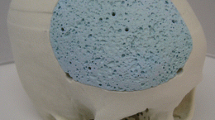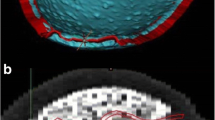Summary.
Summary.
Background:
The development of satisfactory cranioplasty material and technique has been a continuing bio-engineering challenge. Cranial defects resulting from trauma, tumour or infection are most frequently reconstructed with nonviable alloplastic materials. At present, all synthetic or biological materials in the use for human cranioplasty are more or less ideal.
Methods:
The in vivo properties of a fully resorbable bony substitute – hydroxyapatite cement (HAC, BoneSource®) are described in clinical investigations and animal experiments. HAC is prepared from calcium phosphate precursors which are hydrated and harden endothermically at 37 °C to form hydroxyapatite. Bone formation and resorption characteristics of HAC are examined in an adult minipig cranial defect model.
Findings:
Cranial bone integrity has been restored in ten of eleven patients. Radiographic examination 6 months after surgery reveal a successful reconstruction of the skull defects. Sections of the cranial defect site from animals sacrificed at 12, 18 and 40 weeks demonstrate that new bone formation proceeds in HAC filled osseous defects. Histomorphological evaluation of HAC resorption and new bone formation indicates that HAC is nearly completely resorbed within 40 weeks and replaced by new bone with no loss in size or volume.
Interpretation:
Hydroxyapatite cement (HAC) has an excellent biocompatibility (non-immunogenic and non-toxic), seems to be an optimal implant for cranial reconstruction and provides a biological scaffold for bone formation. However, further studies need to be conducted to determine the long-term stability of HAC.
Similar content being viewed by others
Author information
Authors and Affiliations
Rights and permissions
About this article
Cite this article
Verheggen, R., Merten, H. Correction of Skull Defects Using Hydroxyapatite Cement (HAC) – Evidence Derived from Animal Experiments and Clinical Experience. Acta Neurochir (Wien) 143, 919–926 (2001). https://doi.org/10.1007/s007010170022
Issue Date:
DOI: https://doi.org/10.1007/s007010170022




